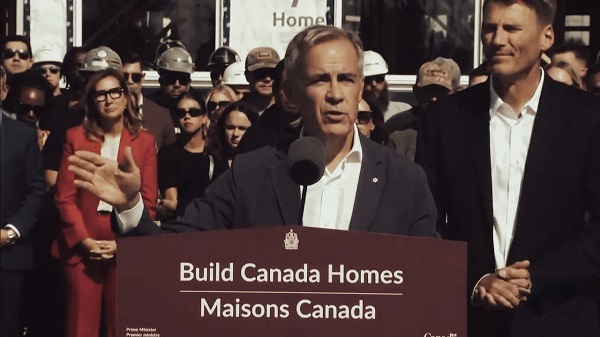Housing
Trump advancing 50-year mortgage to help more Americans buy homes

The Trump administration is preparing to roll out a sweeping new housing initiative — a 50-year fixed-rate mortgage designed to make homeownership more accessible for working- and middle-class Americans. Federal Housing Finance Agency Director Bill Pulte confirmed Saturday that the plan is actively in development, calling it a “complete game changer.”
“Thanks to President Trump, we are indeed working on The 50 Year Mortgage — a complete game changer,” Pulte announced on X, posting a graphic from Trump’s Truth Social page that contrasted Franklin D. Roosevelt’s 30-year New Deal mortgage program with Trump’s 50-year proposal. FDR introduced the 30-year fixed mortgage in the 1930s to lift Americans out of the Great Depression. Nearly a century later, Trump is positioning the 50-year loan as a modern counterpart — a bold step to restore the American Dream for a generation shut out of the housing market.
The proposal comes amid record-high housing prices and interest rates that have pushed the average age of first-time homebuyers to 40 — the oldest ever recorded, according to the National Association of Realtors. In decades past, first-time buyers were often in their 20s or early 30s.
Mortgage data also shows how desperate buyers have become: adjustable-rate mortgage (ARM) applications, once a marginal share of the market, now account for roughly 10% of all applications — far above the post-2008 average of 6%, according to the Mortgage Bankers Association. The surge reflects how buyers are stretching to afford homes amid high monthly payments. A 50-year fixed mortgage would significantly reduce those monthly costs, though borrowers would pay more interest over the long term.
While details are still being finalized, the plan underscores Trump’s focus on affordability and opportunity — reviving the spirit of Roosevelt’s 30-year mortgage for a new era of Americans chasing the dream of homeownership.
Business
Carney budget continues misguided ‘Build Canada Homes’ approach

From the Fraser Institute
By Jake Fuss and Austin Thompson
The Carney government’s first budget tabled on Tuesday promises to “supercharge” homebuilding across the country. But Ottawa’s flagship housing initiative—a new federal agency, Build Canada Homes (BCH)—risks “supercharging” federal debt instead while doing little to boost construction.
The budget accurately diagnoses the root cause of Canada’s housing shortage—costly red tape on housing projects, sky-high taxes on homebuilders, and weak productivity growth in the construction sector. But the proposed cure, BCH, does nothing to fix these problems despite receiving a five-year budget of $13 billion.
BCH’s core mandate is to build and finance affordable housing projects. But this mission is muddled by competing political priorities to preference Canadian building materials and prioritize “sustainable” construction materials. Any product that needs a government preference to be used is clearly not the most cost-effective option. The result—BCH’s “affordable” homes will cost more than they needed to, meaning more tax dollars wasted.
Ottawa claims BCH will improve construction productivity by “generating demand” (read: splashing out tax dollars) for factory-built housing. This logic is faulty—where factory-built housing is a cost-effective and desirable option, private developers are already building it. “Prioritizing” factory-built homes amounts to Ottawa trying to pick winners and losers—a strategy that reliably wastes taxpayer dollars. The civil servants running BCH lack the market knowledge and cost-cutting incentives of private homebuilders, who are far better positioned to identify which technologies will deliver the affordable homes Canadians need.
The government also insists BCH projects will attract more private investment for housing. The opposite is more likely—BCH projects will compete with private developers for limited investment dollars and construction labour. Ottawa’s intrusion into housing development could ultimately mean fewer private-sector housing projects—those driven by the real needs of homebuyers and renters, not the Carney government’s political priorities.
Despite its huge budget and broad mandate, BCH still lacks clear goals. Its only commitment so far is to “build affordable housing at scale,” with no concrete targets for how many new homes or how affordable they’ll be. Without measurable outcomes, neither Ottawa nor taxpayers will know whether BCH delivers value for money.
You can’t solve Canada’s housing crisis with yet another federal program. Ottawa should resist the temptation to act as a housing developer and instead create fiscal and economic conditions that allow the private sector to build more homes.
Business
“Nation Building,” Liberal Style: We’re Fixing a Sewer, You’re Welcome, Canada

Ottawa held a full-blown press conference to announce they unclogged a pipe in Toronto and called it a generational housing strategy.
You probably didn’t hear much about it unless you were watching Canadian state media but this morning, the Liberal government held a press conference in Toronto. It was billed as a “generational investment” in housing. That’s the phrase they used. In reality, it was a sewer project.
Gregor Robertson, the former mayor of Vancouver and now the federal minister of housing and infrastructure, stood beside Toronto Mayor Olivia Chow and a cluster of Liberal MPs to announce that Ottawa is spending $283 million to upgrade the Black Creek trunk sewer line. That’s a pipe. A very old pipe. And according to Robertson, that investment will “unlock” the construction of up to 63,000 new homes in the Downsview area.
If that sounds suspiciously like taking credit for doing your job, maintaining the basic infrastructure cities rely on, that’s because it is. No one has ever accused the Liberals of missing an opportunity to repackage civic maintenance as a national moral crusade. The sewer line is 65 years old. It overflows during storms. It’s been a known problem for decades. Fixing it is not bold housing policy. It’s plumbing.
But the political optics are irresistible. The Trudeau Liberals, now under the leadership of Mark Carney are desperate for a win on housing. Their record is catastrophic. Home prices have doubled. Rents have soared. Entire generations of Canadians have been priced out of ownership and locked into permanent renter status. And the architects of that disaster are now flying around the country handing out ribbon-cutting ceremonies and calling it reform.
Today’s announcement also included the unveiling of the first project under a brand-new federal housing agency, Build Canada Homes. Never heard of it? That’s because it didn’t exist until a few weeks ago. And who’s running it? None other than Ana Bailão a Liberal operative and former Toronto city councillor who spent years helping make the city unaffordable in the first place. Now she’s being rewarded with a cushy federal appointment, tasked with building modular housing and handing out contracts on public land.
And what exactly is Build Canada Homes building? Today, they’re launching 540 homes. Not 63,000… 540. Factory-built units that will be delivered at some undefined point in the future. That’s the big federal breakthrough. A housing crisis affecting millions of Canadians, and Ottawa’s answer is five hundred and forty modular homes in Downsview.
This is the pattern every time. The government breaks something, calls it a crisis, and then demands credit for fixing a fraction of it with your money. The numbers are staggering. According to the Parliamentary Budget Office, Canada needs 3.1 million more homes by 2030 to restore affordability. That means building over 430,000 units per year. Right now, we’re building maybe half that. The backlog gets worse every year. But today, we’re supposed to celebrate because they’re unclogging a sewer and firing up a couple prefab builds on federal land.
No one in the press asked the obvious question: why aren’t private builders constructing the 300,000 units that Toronto has already zoned and approved? Because they can’t. The financing doesn’t work. The cost of materials is too high. Interest rates have crippled developers. And cities like Toronto still impose hundreds of millions of dollars in fees, development charges, and bureaucratic red tape. That’s the real bottleneck. Not the sewer. And here’s what they definitely won’t say out loud: Canada’s housing disaster is not just about supply. It’s about demand, turbocharged by one of the fastest immigration intakes in the Western world. The Bank of Canada has warned repeatedly that immigration targets, set without any link to housing capacity — have blown demand wide open and put relentless upward pressure on rents and home prices.
Mayor Chow admitted it herself, sort of. She said the city has thousands of units ready to build but no takers. And instead of confronting the root causes, monetary policy, taxes, regulatory insanity, the government announces a pilot project and tells you to be grateful. That’s how disconnected they are from reality. They’ve regulated housing out of reach and now they’re posing for photos on a construction site, pretending to be the solution.
And just in case there was any lingering doubt about how deep this failure runs, Statistics Canada released its latest building permit numbers this morning and the trend is exactly what you’d expect in a country where the government makes building homes all but impossible.
The total value of building permits dropped again in August down $139 million to $11.6 billion. Residential permits alone fell 2.4%, driven by steep declines in Ontario and Alberta, the very provinces with the most acute housing needs. Single-family permits fell off a cliff — down more than 10% year-over-year. That’s not a slowdown. That’s a stall.
Meanwhile, British Columbia and Quebec where government intervention is particularly heavy barely managed to offset the damage. The number of new dwellings authorized actually shrank month over month. And this is happening in the middle of a so-called national housing push.
StatsCan didn’t sugarcoat it. They didn’t blame foreign investors or greedy landlords or some phantom market force. They just showed the raw data: Permits are falling. Housing starts are lagging. Builders are retreating.
So let’s just pause here and appreciate the sheer absurdity of what we witnessed. A parade of officials, flanked by branded podiums and tax-funded media handlers, standing in front of a construction site to announce, with straight faces, that they are upgrading a sewer line. And for this, we are told we are “building Canada strong.” Really? That’s the pitch? Fixing basic municipal plumbing is now a nation-building moment?
No! Let’s be clear, you’re not building Canada strong. You’re doing your job. A sewer upgrade in Toronto is not some heroic act of visionary leadership. It’s literally maintenance. It’s what functioning governments are supposed to do, quietly, competently, without a six-camera press choreography and a round of applause from party MPs.
But in Liberal Carney Canada the bar has been lowered so dramatically that simply clearing a permit backlog and patching old infrastructure is treated like a moon landing. They break the system, congratulate themselves for patching one pipe, and expect gratitude.
If you want praise for fixing aging civic infrastructure, something cities used to handle without a national press event, then that tells us everything. It tells us the Liberal government has become so hollow, so addicted to performance politics, that maintenance is now treated as achievement. That’s how far we’ve fallen in just ten years.
They didn’t rebuild a nation. They didn’t launch a housing renaissance. They unclogged a sewer, and are now demanded a standing ovation. And that, in a single image, is modern Liberal Canada: the total collapse of standards, repackaged as progress and sold back to you at full price.
Canadians don’t need more press conferences. They need homes, dignity, and a government that works without constant applause. And if unclogging a pipe is what passes for leadership now — then God help the country.
Subscribe to The Opposition with Dan Knight .
For the full experience, upgrade your subscription.
-

 Business17 hours ago
Business17 hours agoCBC cashes in on Carney as the news industry playing field tilts further in its favour, crippling the competition
-

 Energy2 days ago
Energy2 days agoThawing the freeze on oil and gas development in Treaty 8 territory
-

 Business2 days ago
Business2 days agoWhat Pelosi “earned” after 37 years in power will shock you
-

 Agriculture8 hours ago
Agriculture8 hours agoFarmers Take The Hit While Biofuel Companies Cash In
-

 Business2 days ago
Business2 days agoOttawa should stop using misleading debt measure to justify deficits
-

 Agriculture18 hours ago
Agriculture18 hours agoThe Canadian Food Inspection Agency’s Bloodlust for Ostriches: Part 2
-

 International2 days ago
International2 days agoBBC uses ‘neutrality’ excuse to rebuke newscaster who objected to gender ideology
-

 International2 days ago
International2 days agoLarge US naval presence in Caribbean reveals increased interest in western security






